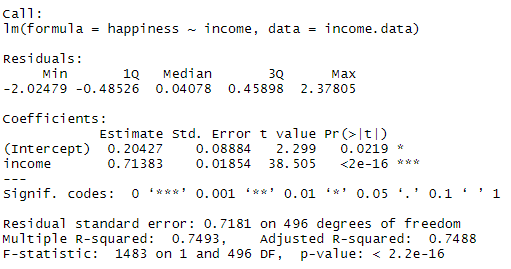Adv Data Science using R Quiz and Assignment 1
These are Advance Data Science Using R Assignment 1 Solution
Quiz
Q1. How do you create a variable named x with the numeric value 5?
int x=5
All of the above
x<-5
x : 5
Answer: x<-5
Q2. How do you insert COMMENTS in R code?
None
// This is a comment
/* This is a comment
Answer: // This is a comment
Q3. What is a correct syntax to output “Hello World” in R?
‘Hello World’
“Hello World”
print(“Hello World”)
All of the other answers are correct
Answer: All of the other answers are correct
Q4. Who is introduced R Programming Language?
Ross Ihaka
Robert Gentleman
Both (A) and (B)
Florian Hahne
Answer: Both (A) and (B)
Q5. When the First appeared R Programming Language?
August 1992
August 1994
August 1993
August 1995
Answer: August 1993
Q6. Which function is often used to concatenate elements?
join()
merge()
paste()
concat()
Answer: paste()
Q7. Which statement is used to stop a loop?
stop
exit
break
return
Answer: break
Q8. Which function is used to find the amount of rows and columns in an array?
dim()
nchar()
length()
dim_len()
Answer: dim()
Q9. How do you start writing a while loop in R?
while x < y:
x < y while
while x < y
while (x < y)
Answer: while (x < y)
Q10. How do you start writing an if statement in R?
if (x > y)
if x > y:
if x > y then:
None of the above
Answer: if (x > y)
Q11. Which function is used to add additional columns in a matrix?
add()
cbind()
join()
append_item()
Answer: cbind()
Q12. Which function is used to draw points (markers) in a diagram?
d()
draw()
plot()
canvas()
Answer: plot()
Q13. How can you assign the same value to multiple variables in one line?
var1, var2, var3 <- “Orange”
var1, var2, var3 = “Orange”
var1, var2, var3 => “Orange”
var1 <- var2 <- var3 <- “Orange”
Answer: var1 <- var2 <- var3 <- “Orange”
Q14. Which operator is used to add together two values?
The & sign
The + sign
The * sign
None of the above
Answer: The + sign
Q15. The following values: 10.5, 55 and 787, belongs to which data type?
numeric
integer
complex
All of the above
Answer: numeric
These are Advance Data Science Using R Assignment 1 Solution
Assignment
Q1. Explain Some of the Similarities and Differences Between R and Python.
Solution:
Key Difference Between R and Python
- R is mainly used for statistical analysis while Python provides a more general approach to data science
- The primary objective of R is Data analysis and Statistics whereas the primary objective of Python is Deployment and Production
- R users mainly consists of Scholars and R&D professionals while Python users are mostly Programmers and Developers
- R provides flexibility to use available libraries whereas Python provides flexibility to construct new models from scratch
- R is difficult to learn at the beginning while Python is Linear and smooth to learn
- R is integrated to Run locally while Python is well-integrated with apps
- Both R and Python can handle huge size of database
- R can be used on the R Studio IDE while Python can be used on Spyder and Ipython Notebook IDEs
- R consists various packages and libraries like tidyverse, ggplot2, caret, zoo whereas Python consists packages and libraries like pandas, scipy, scikit-learn, TensorFlow, caret
Q2. Write and Explain Some of the Most Common Syntaxes in R?
Solution:
- In R, the primary assignment operator is
<-as in:x <- 3- Not
x = 3
- To add to the potential confusion, the equals sign actually can be used as an assignment operator in R — most (but not all) of the time.
- One more note about variables: R is a case-sensitive language. So, variable x is not the same as X. That applies to just about everything in R; for example, the function
subset()would not be the same asSubset(). - To put multiple values into a single variable, you use the
c()function, such as:my_vector <- c(1, 1, 2, 3, 5, 8)- If you forget that
c(), you’ll get an error.
- Performing a mathematical operation on a vector variable will automatically loop through each item in the vector. Many R functions are already vectorized, but others aren’t, and it’s important to know the difference.
if()is not vectorized, for example, but there’s a versionifelse()that is.
Q3. (a) How Do You Assign a Variable in R?
(b) List Some of the Best Packages For:
i. Data Visualization
ii. Data Mining
iii. Data Imputation
Solution:
(a):
There are different ways to define a variable in R which are:
- In R, a variable always starts with a letter or with a period. A variable if started with a dot cannot be succeeded by a number.
- Variables cannot be created with keywords which are already predefined in R; that is keywords which are reserved, as their names or identifiers.
- A variable in R can be defined using just letters or an underscore with letters, dots along with letters. We can even define variables as a mixture of digits, dot, underscore and letters.
- In R, a few instances of names of variables that are relevant are name, Var, var_1, .var, var.1
(b):
(i): Packages for Data Visualization
- ggplot2.
- Lattice.
- highcharter.
- Leaflet.
- RColorBrewer.
- Plotly.
- sunburstR.
- RGL.
(ii): Packages for Data Mining
reshape
sna social network analysis
tm: a framework for text mining applications
lda: fit topic models with LDA
topicmodels: fit topic models with LDA and CTM
RTextTools: automatic text classification via supervised
(iii): Packages for Data Imputation
- MICE
- Amelia
- missForest
- Hmisc
- mi
These are Advance Data Science Using R Assignment 1 Solution
Get more about R language here:
Advance Data Science using R all weeks assignments: Click Here

